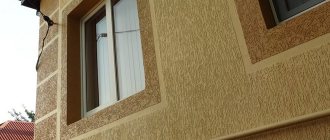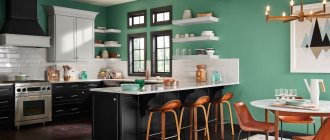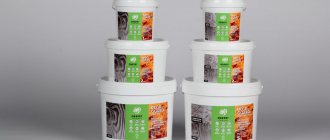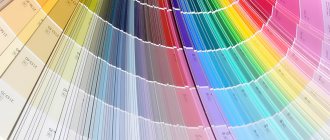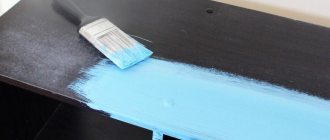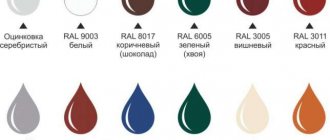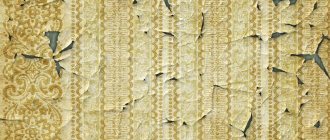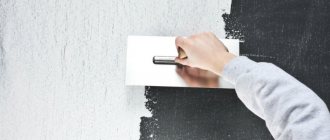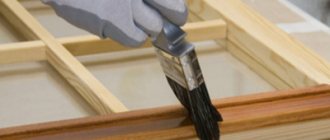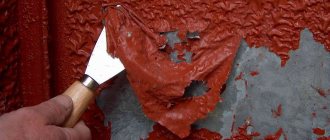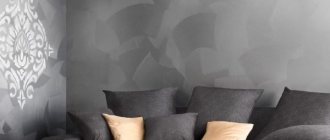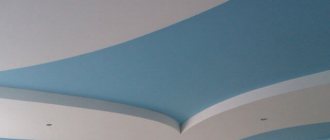Water-soluble paste "Palizh"
Decorative plaster is usually supplied in a basic white color. To obtain a coating of the desired shade, you can use two methods: add color when mixing the solution or paint the composition that has already been applied to the wall and dried.
The advantage of tinted plaster is that in case of minor damage - scratches, small chips - the defect is not noticeable, since the inner layer has the same color as the surface and therefore will not stand out.
A little about bark beetle plaster for facades
The material is a universal decorative finish.
The compositions differ in purpose (for interior and exterior decoration), granule sizes (small and large fractions), fillers, level of plasticity and other performance characteristics.
The list of advantages of the type of plaster mixture includes bark beetle:
- creating a strong and durable coating;
- durable application;
- the ability to level the surface due to the structural texture;
- no shrinkage - prevents the formation of cracks and chips;
- resistance to temperature changes;
- moisture resistance of the coating;
- small load on the floors;
- environmental friendliness, because the material is made from natural ingredients;
- wide range of shades;
- resistance to mechanical damage;
- possibility of painting the coating;
- affordable price;
- the presence of several application techniques;
- possibility of multi-color toning;
- resistance to frost and fire;
- no fading of the coating under ultraviolet rays.
Surface preparation
When painting the surface layer, you need to take into account the level of preparation and the nuances that arise due to the uneven texture of the base. The face composition is made with a two-layer texture. The plane imitates the chaotic movement of a bark beetle. The effect is obtained thanks to the mineral particles included in the plaster recipe.
During grouting, the elements move along the base and form uneven depressions. It is these grooves that cause problems when painting facade walls yourself. When the plastering work has been completed and a full-fledged pattern has been formed, it is necessary to erase all unattractive places in the joint area and evenly treat the entire surface layer without strong pressure on the pattern.
Note! Is it necessary to prime the bark beetle before painting? The answer is yes. This technique will improve adhesion and extend the service life of the front surface.
Advantages and disadvantages of painting for bark beetles
Painting of decorative bark beetle plaster is carried out taking into account the peculiarities of tinting the porous structure of the treated surfaces.
The dense layer needs to be updated by painting to solve the following problems:
- interior renovation without major renovation;
- increasing the protective characteristics of the plaster layer from high humidity;
- visual expansion of the room (using two-color processing or using triple tinting);
- increased resistance to mechanical damage;
- enhancing the operational characteristics of the layer.
The list of shortcomings that are taken into account before painting a bark beetle includes;
- the complexity of multi-layer tinting due to the textured structure of the base;
- the need to use a set of tools and several application techniques;
- reduced aesthetics when using a single color coating for a complex textured base.
Classic way
In this case, the procedure involves using one color. In this case, a uniform layer is applied in one step. To do this, spread the paint with a long-haired roller or using a sprayer, while simultaneously painting the grooves and recesses carefully with a brush. During the painting process, smudges will appear, which must be immediately rubbed off with a sponge or mitten.
The paint is applied up and down with a roller, but each subsequent vertical layer must cover the previous one. When using a brush, the direction of the tool should be alternating - sometimes vertical, sometimes horizontal, which guarantees uniform application of the layer.
To save money, you can use a tinted primer, which is directly applied to the plaster. After this layer has dried, the paint is applied with a roller, but additional painting of the recesses is no longer necessary.
To simplify the painting procedure, you can use the plaster tinting method. To do this, you need to add the colored pigment directly to the solution before applying it to the walls.
An important condition for uniform painting of the bark beetle is to create the same shade for all the required solution. After the finishing layer has dried, apply another layer of paint on top with a roller, but avoid getting it into the recesses.
It is worth understanding that only polymer acrylic plaster can be tinted. Cement dry mixtures cannot be pigmented, since when more than 5% of coloring pigment is added, their quality sharply decreases, which affects wear resistance.
Which paint is best to choose for painting exterior and interior work on bark beetles?
Before painting bark beetle plaster, you need to select the appropriate type of dye, taking into account the purpose (inside the building, facade decoration), and the type of room (bedroom, living room, hallway). They determine what to paint plastered surfaces with, taking into account the operating temperature, air humidity level, etc.
The following types of paints are used in finishing the coating decorated with bark beetle plaster mixture:
- oil;
- alkyd;
- acrylic.
Some manufacturers produce paint products with a bark beetle effect and special compositions for tinting plastered surfaces.
Manufacturers offer decorative paints to create original effects on substrates. You can choose dyes that imitate sand, silk fabric, stone, genuine leather, etc. Compositions are available to imitate aged and patinated surfaces, reproducing silk-screen printing, velvet or velor surfaces.
These products are of high quality and have a high cost due to the inclusion of mother-of-pearl, silk and other particles. It is possible to create an accent wall panel tinted with pearlescent dyes with a metallic sheen.
The paint color scheme is selected according to the type of room:
- for bedrooms, calm neutral shades (sand, light gray) are recommended;
- living rooms are decorated with more saturated color combinations (combinations of blue and ocher, brown, green, burgundy);
- the kitchen is decorated in different shades depending on the design project; it is possible to use bright colors (yellow, orange, green) or sand, dark brown;
- paints of rich shades (bright orange, green, yellow) are used to decorate children’s rooms;
- in a high-tech style office you can combine dark blue, black dyes with a glossy sheen and white, silver shades.
Oily
Can be used for tinting plastered textured surfaces. The paint has a thick consistency, forms bases rich in color, has an affordable price, is economical to use, and is available in a wide range of shades. However, when applying the composition, it is necessary to take into account the sharp odor of the material, low vapor permeability and fire resistance, and the possibility of fading from ultraviolet rays. The material is negatively affected by alkaline solvents and detergents with abrasive particles.
Alkyd
Such enamels can be used to decorate bark beetle plaster coatings indoors and for outdoor work. The material is optimal for facade finishing, because... forms a durable coating, increases the resistance of the base to climatic precipitation and changes in temperature conditions.
The list of advantages of the dye includes high water-repellent characteristics and resistance to various types of detergents. Work is carried out in a ventilated room or in the open air, because... the dye has a pungent odor. The material is affordable and comes in a wide range of shades. Plastered surfaces treated with alkyd paint do not fade and are resistant to mechanical stress, mold and fungi.
Acrylic
Plaster is painted with dyes of this type. The material is optimal for finishing interior spaces and easily tints plastered surfaces.
Acrylic paint has the following advantages:
- consists of environmentally friendly components and is safe to use;
- the acrylates included in the dye increase the strength of the tinted layer and the durability of the plaster;
- has no odor and is used in the decoration of children's rooms and bedrooms;
- has good vapor permeability;
- features a wide range of shades;
- universal and can be used for different types of surfaces.
Acrylic dyes are divided according to their composition into the following subtypes:
- waterproof;
- lightfast;
- washable.
It is recommended to determine which paint to tint the plaster layer, taking into account the purpose of the room, the type of finishing (facade, interior), and base material.
Manufacturers indicate on the packaging the conditions for using paint. The choice is made in accordance with the design decision.
Acrylic paints can be:
- matte;
- semi-matte;
- with a glossy shine;
- silky.
What primer to use
Currently, the following types of primers can be found on sale:
Types of primers
Next, we will consider in which cases which of these compositions are used for decorative plaster.
Adhesive
The name of this group of primers speaks for itself - they are designed to improve adhesion. Accordingly, adhesive primers should be applied to smooth surfaces such as concrete.
The diagram shows the principle of operation of adhesive soil such as concrete contact
Adhesion is improved due to the presence of fine abrasive in the soil composition. Those. The base after priming becomes rough like sandpaper. Thanks to this, decorative plaster adheres well.
Most often, sand or needle quartz is used as an abrasive. Those. the soil, in fact, is a water-based binder (adhesive) with a filler in the form of solid mineral particles.
High-quality soil from Knauf - betokontakt
Price:
| Brand | Price in rubles |
| Perfecta 10 l | 620 |
| VGT 8 kg | 800 |
| Tikkurila Otex 9 l | 5900 |
| KNAUF-Betokontakt 5 l | 600 |
All prices indicated in this article are current in spring 2017.
The soil penetrates into the pores of the base and strengthens it
Deep penetration
The main property of deep penetration soils is the ability to penetrate deep into the structure of porous surfaces (up to ten centimeters). In this case, the liquid has the property of a binder.
After treating surfaces with deep penetration soil, they acquire higher strength. The need for such a composition may be necessary if you decide to apply bark beetle, for example, to old plaster that is dusty and crumbling.
The photo shows deep penetration soil from the domestic manufacturer Etalon
Price:
| Brand | Price in rubles |
| Perfecta "Expert" 5 l | 260 |
| Standard 10 l | 400 |
| Litokol 2 l | 350 |
High-quality universal primer from the German manufacturer Ceresit
Universal
It’s not for nothing that universal soils are called such – they have all the functions listed above:
- Improve adhesion;
- Strengthen the surface;
- Creates a film for uniform absorption of moisture.
Such compositions are suitable for application to plasters, adhesives used in “wet” facades, etc.
Dufa Putzgrund - a proven primer from a Finnish manufacturer
Price:
| Brand | Price in rubles |
| Dufa putzgrund 10 l | 900 |
| Ceresit CT-17 10 l | 640 |
| Knauf-Tiefengrund 10 l | 630 |
| Optimist | 400 |
Primers differ not only in the type of action, but also in the area of application. They can be used externally, for internal use and universally. Compositions for interior work are more environmentally friendly than their façade counterparts.
What does painting on the facade give?
Tinting the plaster composition can be done by adding color to the mixture, varnishing or waxing the surface. However, painting the bark beetle in two or more shades allows you to create an original design for the room, increase the strength of the base and the protective characteristics of the coating.
With the help of tinting, you can zone the space without the use of additional finishing materials. You can paint the surfaces with elegant paintings, ornaments, reproduce reproductions of paintings, etc.
What else you need to know about facade painting
Before painting the bark beetle, experts recommend taking into account the following nuances that simplify repair work:
- To obtain a uniform surface and reduce labor costs, craftsmen advise adding the required color to the plaster mixture to match the tone of the future dye. Painting work will be completed in a short time.
- When purchasing material, it is important to choose certified quality products. Facade paint must be safe. When using licensed products, a durable and safe coating is created.
- Before painting the plastered surface, it is recommended to thoroughly dry the base layer. When applying dye to an undried base, streaks will remain and the coating will be uneven.
Choosing the right paint
There is no special bark beetle paint for interior plastering work.
You should choose from the classically common options:
- Oily . Despite the brightness and richness of color, this suspension has many disadvantages, including increased flammability, fear of alkaline influences and lack of vapor permeability. Today there are better analogues.
- Alkyd . It is characterized by low price and high resistance to aggressive environmental influences. But the presence of a specific unpleasant odor makes their use indoors not the best idea. Therefore, it is advisable to leave them for facade work.
Using alkyd suspension for facade finishing
- Acrylic . The water base makes this composition environmentally friendly, and acrylates, which act as a binder, provide strength and moisture resistance. Durability, a wide range of colors and vapor permeability are also inherent in this type of solution. This is the most optimal paint for bark beetle in terms of its technical characteristics.
A variety of shades of acrylic compositions
Advice: if you need to obtain any unusual color, use a special tinting machine. The ability to mix percentages and many pre-programmed “recipes” will help you create a unique shade and repeat it if necessary in the future.
It should also be noted that there is a special bark beetle paint for metal. It creates a similar decorative effect on an iron surface without the use of plaster.
Bark beetle painting technology
You can paint the bark beetle with your own hands in several ways:
- contrasting blocks;
- slightly update the texture emphasizing the previous color scheme;
- using tinting in stripes or areas with contrasting shades to delimit functional areas in a living room or apartment with a studio layout;
- with a patination or gilding effect (this will add luxury) to the interior.
The work is carried out in compliance with the following stages:
- cleaning and leveling surfaces;
- choice of design solution;
- applying a base layer of coloring composition;
- finishing work.
Preparatory work and tools
Before painting the bark beetle in two colors or performing a single-color coating, you need to prepare the surfaces. It is necessary to cover furniture, non-paintable areas of the interior, and lamps with plastic sheeting. It is necessary to vacuum the plastered surface or remove dust and small crumbs with a dry cloth.
You can determine whether the bark beetle needs to be primed before painting, taking into account the quality of the base. If there are any irregularities, treatment is required. The coating is applied evenly, the recesses are filled with soil.
The work will require the following tools:
- rollers:
- a set of brushes (compact, wide);
- sponge;
- spray;
- containers for paint, etc.
The work is carried out in special clothing, the kit includes a respirator, goggles, and gloves.
Applying paint to the wall
Experts recommend first applying the dye to a small area of the wall to check the compatibility of the shades. The main surface tinting is performed after the primer layer has dried. In the living space, painting is carried out with a high-quality acrylic or water-based composition. The material is applied from top to bottom to prevent drips.
It is important to determine which roller is optimal for applying paint. The standard tool used is medium bristle. Wide areas are processed with a roller. Corner and other hard-to-reach areas are painted with a brush.
Process adjustment
In order to soften color contrasts as much as possible, the paint can be rubbed with a soft rubber sponge or mitten.
The same can be done in cases where it is important to give the walls a certain relief with a touch of antiquity. Paint with a shade of gold or silver is applied to the recesses and protrusions, barely touching the facade elements with a brush to avoid oversaturation.
It is also worth describing the principle of painting walls with a combination of textured and smooth areas. Craftsmen recommend starting to paint the facade with the design of textured elements.
It would be advisable to start painting a smooth surface only after the textured areas have dried. When re-staining, these rules do not need to be followed.
Various options for painting the facade of a house using plaster
Several options for coloring bark beetle plaster mixture have been developed.
On the list of those in demand:
- adding color to plaster;
- painting in two layers;
- tinting the primer.
First option: initial tinting of the paint mixture
A simple way to tint is to tint the solution. It is important to correctly assess the proportions of adding dye to the plaster mixture. The color is added to the plaster at the mixing stage. The solution is then applied to the surface. The coating must be thoroughly dried for 2-3 days.
At the next stage, the surface is painted in different ways, including:
- Using paint of the same color scheme with a tinted plaster mixture. It is permissible to use a dye of a darker tone.
- Using a shade different from the plastered base.
- Painting with a roller or a special apparatus with a sprayer to achieve a uniform color of the textured base.
Second option: double coloring
Painting the plaster layer in two colors or monochromatic tinting in two shades looks impressive in an apartment. The technology makes it possible to increase the strength of the base, prevent cracking of paint, and increase the service life of the room.
The work is carried out in stages:
- The first treatment is carried out with a dense thick layer to fill small depressions on the surface.
- Then the surface is blotted with a sponge to remove excess paint.
- After the first layer has dried (readiness time is indicated by the manufacturer on the packaging), re-painting is performed using a fine-pile roller. Painting in two colors should be carried out promptly to prevent the formation of uneven surfaces.
When double painting, you can use the technique of creating textured patterns and blurred spots on a base treated with a mixture of bark beetles.
The work is performed in the following sequence:
- The walls are tinted in the base color.
- Using a sponge or brush, a pattern is created on the surface with paint of a different tone.
- It is possible to use rollers with a stencil pattern to create a textured pattern.
Rules for tinting
Exact instructions for use are indicated on the packaging for a specific composition, but the main points are the same.
To work, you will need a container in which the solution will be mixed (polymer mixtures can be painted in factory containers), a drill with a mixer attachment, an electronic scale and a 10-20 ml syringe.
Procedure:
- The bottle of tinting paste is shaken to mix the components.
- Draw a small amount of colored paste into a syringe. The label usually shows a table with the dosages required to obtain different shades. If the bottle has a dispenser cap, you can add it drop by drop, but using a syringe will be more accurate.
- Ready-to-use plaster (or putty) is measured into a small container for test painting. It is enough to measure 200-250 g on the scales.
- Next, a test tinting is done. Color is added from a syringe to the white plaster. Be sure to apply the resulting sample onto a white sheet of paper and write down the proportions of the materials there. For example, 250 ml of plaster + 2 ml of color.
- If the resulting shade is not bright enough, then you need to add more pigment to the sample. If too much dye has been added and the color becomes overly saturated, you can lighten it by adding more plaster. Write down the result again.
When you are satisfied with the result of the test coloring, you can easily calculate the required color consumption for the entire available volume of the decorative mixture.
